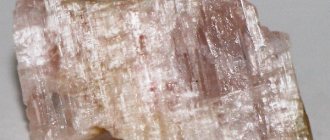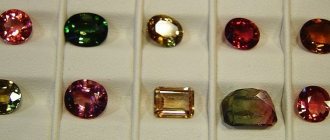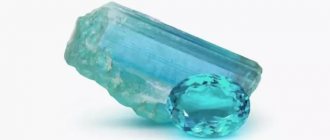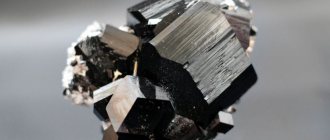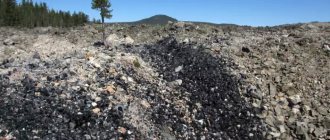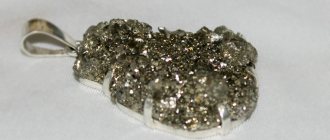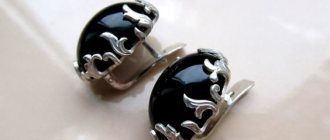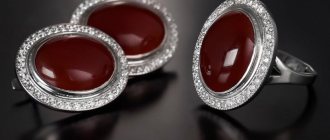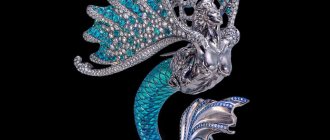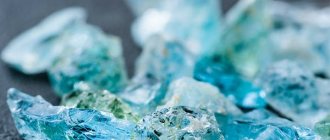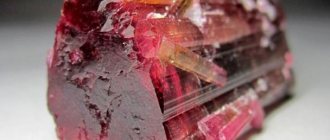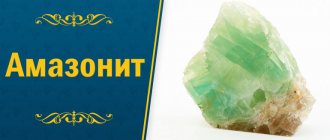Historical reference
Tourmaline was known to the healers of Ancient Rome, Byzantium and Rus' (XIV century). Three hundred years later, Europe became acquainted with the stone. The history of the appearance of the gem on the continent is connected with Dutch sailors.
The name of the stone comes from the Sinhalese word "turamali" or "toramalli" which is applied to various precious minerals in Sri Lanka. Until the 14th century, red varieties of tourmaline were in circulation under the general name “lal”.
The term "turmali" in the local dialect means "stone that attracts ash" or "magical multi-colored stone."
The legendary gem in the form of a bunch of grapes is the “Caesar's Ruby”. According to legend, Cleopatra gave it to Caesar. Then traces of the stone were lost, it wandered around the countries until it came to the Swedish king in the 18th century. Gustav VIII presented it to Russian autocrat Catherine II.
Catherine's bunch of grapes
From the day it appeared, the “bunch of grapes” was considered ruby. Only in the 20th century did they find out that this is Burmese pink tourmaline. The jewel is the property of the Diamond Fund of Russia. Another famous Russian artifact is the 500-carat stone in Anna Ioannovna’s crown.
Interesting facts about tourmaline
- One of the legends about the discovery of tourmaline tells that the gods of Egypt once flew from the center of the Earth to the Sun, and along the way they flew through the rainbow and collected every shade of it, which they then brought back to Earth, where they gave birth to gems.
- Kings loved beautiful tourmalines very much. Thus, at the end of the 18th century, King Gustav VIII of Sweden presented Russian Empress Catherine II with a bunch of grapes made of crimson-red tourmalines with green enamel leaves around. The weight of this gift was 255 carats. Anna Ioanovna's crown was also decorated with 500 carats of tourmaline.
Conditions for the formation and location of tourmaline
The origin is endogenous, high-temperature, pegmatite, metamorphic, hydrothermal-metasomatic.
Polychrome tourmaline crystal, height 2 cm
Most tourmaline deposits are associated with acidic igneous rocks and are common in many granites and granitoids, where they are formed in the last stage of cooling of intrusions. Characteristic of various granite pegmatites (scherl, indigolite, polychrome tourmalines). They are found in pneumatolithic-hydrothermal deposits, in feldspathic-quartz, tourmaline-quartz veins together with cassiterite, wolframite, beryl, and topaz.
Found in greisen (elbaite), in high-temperature hydrothermal sulfide-quartz veins and in zones of near-vein alteration of host rocks.
It is found in small quantities in contact-metamorphic rocks associated with acidic granites, in skarns, and hornfels.
The mineral is resistant to physical weathering and transport and redeposition and therefore accumulates in placers in association with hematite, corundum, zircon, and spinels in quartz sediments.
Artificial production of mineral
The synthesis of tourmaline is carried out by the interaction of NaCl-H3BO3 solutions with corundum, magnetite and quartz at a temperature of 350° and a pressure of 2000 atm or at 550° and 700 bar for 72 hours. Instead of NaCl, you can use NaF, and instead of corundum - diaspores (at a temperature of 425°).
Diagnostic signs
It differs from hornblende, epidote, augite, acmite, lieurite, and emerald in the characteristic triangular cross-section of the crystals, as well as in the pleochroism pattern of the colored varieties and the absence of cleavage. In sedimentary rocks, colorless tourmaline is similar to andalusite and topaz, from which it differs in birefringence.
Satellites. Quartz, micas, albite, fluorite, grandidierite, cordierite, potassium feldspar, biotite, spessartine, muscovite, beryl, petalite, pollucite, microlite, native bismuth, phenacite, desmin, clinochlore, rutile, diaspore, microcline, astrophyllite, aegirine, arfvedsonite , axinite, stillwellite, cherry sodalite, ephesite, chrysoberyl, corundum, gilbertite, chalcopyrite, tetradymite, apatite.
Physical and chemical properties
Tourmaline contains at least 25 elements, but the chemical composition of the stone is variable. The dominance of any impurity creates the main color of the mineral. One crystal can have several colors.
| Property | Description |
| Formula | Na(Li,Al)3Al6[(OH)4|(BO3)3Si6O18] |
| Color | Pink, red, orange-brown, green, blue, red-violet, colorless, black, polychrome. |
| Shine | Glass |
| Transparency | From transparent to opaque. |
| Hardness | 7-7,5 |
| Cleavage | Unclear |
| Kink | Uneven, small-shelled; fragile. |
| Density | 3.02-3.26 g/cm³ |
Physico-chemical characteristics of tourmaline
By chemical nature, tourmaline is a complex boron-containing silicate of aluminum, magnesium and iron.
Its composition and appearance are very diverse due to the presence of impurities of potassium, chromium, titanium, vanadium, beryllium, rubidium, cesium, and zinc. Tourmaline crystals are characterized by trigonal structure, lack of cleavage, transparency or opacity, glassy luster, and uneven conchoidal fracture.
Hardness on the Mohs scale 7.5. Specific gravity 3.2 g/cm3. The light refraction is 1.616-1.652.
Place of Birth
The deposits are widespread and numerous. The most famous are in Sri Lanka, Madagascar, China, Mozambique (polychrome and red tourmalines), Brazil (states of Minas Gerais, Bahia), Burma, Angola, Australia, India, South Africa, Canada (province of Ontario), USA (states California, Maine, Colorado), Italy (Elba Island), Switzerland, Tajikistan (Kanibadam, Kuchkak Mountains), Russia (Urals, Transbaikalia).
Tourmaline (elbaite) is polychrome with quartz and clevelandite. USA, pcs. California
In the Urals, the main deposits of tourmaline were located in the area of the villages of Lipovka, Murzinka, Sarapulka, Shaitanka, Yuzhakovo. Currently, these deposits have been developed and finds of tourmaline in them are extremely rare.
The best tourmaline in Russia is mined in Transbaikalia at the Malkhan deposit and in a number of others. It is also found on the Kola Peninsula in the Voronye tundra (pink and green tourmalines, schorl), in Karelia (sherl).
Tourmaline-elbaite is polychrome, intergrown with quartz. Afghanistan
Jewelry tourmaline is known in Afghanistan (Nuristan): in the deposits of Darae-Pich, Kanokan, Jabo, Chormax, Kantiva, Mandanesha, Tsotsum, Mualevi, Papru.
Large deposits of tourmaline are located in the USA, in the states of Maine and California. These deposits have been known to the Indians since ancient times, but their development by white Americans began only in the 19th century. During this period, American tourmalines were in great demand; they were often purchased, for example, by the Chinese Empress Cixi. By the 1900s, the United States became the world's leading producer of tourmalines.
Elbaite type
Elbaite - elbaite. The name after the location of the discovery on Elba Island was originally proposed by V.I. Vernadsky in 1913 in relation to the final member of the isomorphic series of tourmalines, rich in Al and containing Li. Currently, many colored and colorless tourmalines with a high Al2O3 content and often rich in Li are combined under this name. In their structure, the Y position is occupied by Al, Fe 3+ (little) and Li (not always), and Z is occupied only by Al. This also includes tourmalines that are rich in Al, but poor in divalent cations and do not contain lithium.
Varieties of elbaites by composition
The most individualized of them are tsilaisite and zinc tourmaline.
- Tsilaisite - tsilaisite. Manganese elbaite from Urulga.
- Kunitz named the manganese end member of the isomorphic series tsilaisite after the deposit
- Tsilaizita in Madagascar. In terms of chemical composition, tsilaisites in most cases belong to the elbaite type, but they can also be Fe 3+ -tourmaline.
- Zinc tourmaline. Installed in amblygonite-containing; Muika pegmatite (Congo).
- Liddicoatite - liddicoatite. Named after D. T. Liddicoat. Calcium variety of elbaite Ca(Li, Al)3Al6B3Si6O27(O, OH)3•(OH, F).
Varieties of elbaites by color
- Rubellite - rubellite, pink tourmaline.
- Verdelite - green tourmaline.
- Indigolite - indigolite, blue tourmaline.
- Africite - aphrizite, dark blue, almost black.
- Achroite - achroite, colorless tourmaline.
Varieties and colors
Minerals are generally distinguished by their shade, but other classifications are also possible:
- by degree of rarity;
- on transparency;
- at the place of production.
There are plenty of varieties of this stone. Not only is it impossible to remember them all, it’s impossible to list them all. We decided to focus on describing the 9 main types of tourmaline.
Rubellite
Rubellite
This group includes all tourmalines in red and pink shades: from soft pink to dark burgundy. The highest quality ones were often confused with rubies.
Schorl
Sherl
The rich black color of the stone is due to its high iron content. Sherl is not very valued among jewelers and is rarely found in jewelry, but it is respected by healers and magicians. By the way, this particular mineral is not transparent.
Polychrome tourmaline
Polychrome tourmaline
Polychrome tourmalines are those that have several color zones. That is, one stone combines 2 or even more shades at once. These minerals look very unusual and have a corresponding price.
Paraiba
Paraiba
Stunning turquoise and soft blue stones are mined in Brazil and Africa. These minerals do not cast shadows and appear perfectly transparent. Paraiba tourmaline is considered one of the most expensive gemstones in the world.
Watermelon
Watermelon Tourmaline
As the name suggests, this stone resembles a slice of watermelon. The inside is red or crimson with black splashes, and the outside is green. This mineral looks simply amazing and is definitely suitable for watermelon lovers.
Chameleonite
Chameleonite
Another unusual variety that changes color in different lighting conditions. On the street it appears green, but at home (with artificial lighting) it appears pink or red. Why is this happening? Because the elements that make up the mineral reflect sunlight and artificial light differently.
Indigolite
Indigolite
This type includes all stones of a blue hue. Dark blue specimens are considered especially valuable. Sometimes more expensive Paraiba minerals are counterfeited with indigolites. To do this, they are bombarded with copper ions or immersed in a container with acid.
Chrome tourmaline
Chrome Tourmaline
Due to its high chromium content, tourmaline acquires a rich green hue. Such stones are very similar to emeralds, for which they are especially valued by jewelers.
Achroite
Achroite
Colorless tourmaline is also called elboite, as it is mainly mined in Germany, on the Elbe River. These gems resemble diamonds and are often used in jewelry.
Tourmaline - official healer
Negative ions increase cell vitality, relieve fatigue, calm nerves, strengthen the immune system and improve indoor air quality. It is this property of the stone that was used to create special healing chandeliers. As you know, high-voltage wires, radiation from mobile phones and many other modern inventions of mankind contribute to the formation of positive ions. The negative ions generated by tourmaline are necessary to compensate for the damage caused by positive particles. The mineral can create protection against electromagnetic radiation and neutralize vulnerability in geopathogenic zones.
Yellow crystals with their constant magnetic field are most often used in medicine. They are used to combat pathologies in the body without the use of drugs. Their fibers are used to make knee and elbow pads, socks, insoles, motion sickness belts, bandages, scarves and gloves.
Although some doctors and physical therapists are skeptical about this type of product, its popularity is growing. The use of the drugs has no side effects or contraindications, but caution should be exercised by pregnant women and nursing mothers, people with high blood pressure and a tendency to bleed, as well as people with cancer. When using a pacemaker, after a stroke, with elevated temperature and allergies, you should consult your doctor.
The therapeutic effect occurs only with regular use of the products. One procedure will only dull the pain.
Medicinal properties
Eastern medicine classifies tourmaline as a powerful healer and cleanser of the body and aura. The mineral is a real storehouse of useful substances and contains 26 elements of Mendeleev’s periodic table - iodine, silicon, fluorine, iron, manganese, magnesium, calcium, potassium and many others.
Ring with tourmaline
Tourmaline is a rich source of microelements, a balancer of biocurrents, and an emitter of infrared rays and negative ions.
The length of infrared rays of tourmaline is 14-15 microns.
Constant microcurrent of negative ions – 0.06 mA.
Trace elements and twisting fields of tourmaline are very beneficial for human health. At the same time, products made from tourmaline are not only useful, but also beautiful! Wearing “electric” jewelry is a pleasure. Radiant stone is unusual both in appearance and on the energetic level.
Versatility is one of the most important healing properties of tourmaline. The stone itself interacts with human energy and regulates biocurrents and the functioning of all systems. It is enough to periodically wear jewelry with tourmalines to help your body cope with diseases and carry out their timely prevention.
You can wear “electric” stones at any time of the year. Their charge level does not depend on the weather or air temperature. When tourmaline is on the human body, under the influence of natural heat, a low-frequency magnetic field is formed, which is emitted by anions. This provides a large-scale healing effect on the body:
- soothing muscle pain;
- reduction of rheumatic diseases;
- regulation of the nervous system;
- normalization of the hormonal and endocrine systems;
- normalization of the lymphatic system;
- strengthening the immune system;
- elimination of headaches;
- improving blood quality;
- replenishment of thin capillaries;
- normalization of blood pressure;
- improvement of metabolism;
- strengthening cellular metabolism;
- protection from stress and negative energy effects;
- relieving symptoms of fatigue;
- the complexion is refreshed.
Ring pink tourmaline (rubellite) Russia
If you wear products made from tourmaline, microcurrents flowing along its surface balance the biocurrents of the human body. The negative ions that tourmaline emits deeply balance all body systems and alkalize acidic liquids. With the help of emitted infrared rays, capillary vessels expand, blood circulation is stimulated, cellular work is activated, the metabolic process is accelerated, etc.
The incredibly powerful healing properties of tourmaline are used all over the world in both traditional and folk medicine.
Indian lithotherapists today work with a wide variety of color varieties of tourmalines. With the help of red and pink tourmalines, the circulation of Yang energy flows is restored, and with the use of green, blue and black - Yin energy.
Green tourmalines help treat diseases of the liver, nervous system, blood circulation, and cope with skin diseases. With the help of colorless tourmalines, they balance spiritual and physical forces and cleanse the mind.
Contraindications to wearing jewelry with tourmaline - the opinion of official medicine
Tourmaline accessories and other products made from this mineral have a certain energy potential, and different varieties have different effects on the human body. Alternative health practitioners warn that black schorl is contraindicated in people suffering from lack of fluids. It should not be worn if you are experiencing weight loss, dry skin, dry mucous membranes or other signs of dehydration.
Green tourmaline is not recommended for women as it disrupts their energy balance. If a woman needs to undergo green stone treatment, it is permissible to wear it only for a short time. During treatment with this mineral, listen to the body’s reaction and if any unpleasant or suspicious changes occur, contact a specialist.
The magical properties of tourmaline
A tourmaline crystal is capable of creating a magical force field around the owner. It reliably protects a person from any mental negativity or curses. The mineral is also capable of neutralizing the harmful effects of electromagnetic fields from computers, televisions, and microwave ovens.
Pendant pink tourmaline (rubellite) Brazil butterfly
The effect of a gem on the human body is determined by its color.
- Green tourmaline helps a person regain faith in himself, find an inner core, and firm guidelines in life.
- Psychics recommend wearing a red gem to those who want to attract more attention from the opposite sex.
- The pink stone is one of the most powerful amulets for women; with its help, a person can get rid of the habit of self-digging, timidity, and dependence on other people.
- The watermelon crystal will help the wearer become more sensitive to other people, develop intuition, and teach them to sense falsehood, lies, and hypocrisy. It also gives optimism and increases libido.
- The raspberry mineral is more suitable for creative people, for whom it will become a real muse, give new ideas, and suggest ways to implement them.
- Lilac, or achroite, will help calm the nerves.
- Blue stone is a good gift for newlyweds or any married couple. It strengthens marriage, brings peace, love, and mutual understanding to the family.
- Paraiba heals from neuroses, anxiety, depression, and teaches a philosophical view of life's difficulties.
- Indigolite is suitable for those who are on a spiritual quest, as well as researchers and scientists. He guides such people on the right path.
- Brown stone helps improve physical well-being, returns joy and the will to live to the wearer.
- Black tourmaline is stronger than other types of mineral in neutralizing negative energy. Psychics advise wearing such a crystal to people who suffer from constant outbursts of anger, aggression, and hatred. It will help them become calmer and more balanced.
A mineral of any color “becomes attached” to the owner, strives to protect him from adversity, and suggests ways out of crisis situations. It will help you find your purpose and show the wearer what the meaning of your life is. Thanks to the magical properties of tourmaline, a person becomes more purposeful; those things that are not related to the goal fade into the background.
Effects of red tourmaline on the body
The main focus of red tourmaline in treatment is restoration of the endocrine system, blood circulation and cleansing of blood vessels.
It is believed that this mineral promotes better blood flow, increases the amount of oxygen in the blood, which helps renew the entire body and significantly slows down the aging process. Red tourmaline is an effective remedy for combating genitourinary disorders. This stone enhances potency and successfully fights sexual impotence, the development of prostatitis, and premature ejaculation. Useful for the prevention of female ailments, as well as combating flora disorders, inflammatory processes of the uterus and ovaries, including effective against cysts. They ease menstruation and increase the level of sexual activity. It was these properties that gave the red mineral the fame of an aphrodisiac.
The mineral is effective as a prophylactic against neuroses, insomnia, anxiety, loss of sleep, as well as a number of infectious diseases and heart diseases. The stone is also effective for colds and other infectious diseases. Tourmaline is a good remedy for the prevention and treatment of varicose veins, especially in the early stages of the disease.
Red tourmaline stone has properties that are important for people of different ages, and is equally effective for both men and women. The intensity of use of the mineral, as well as the duration of tourmaline exposure sessions, depends on the personal desire of the patient. It is recommended to initially give minimal exposure to this stone to your body, gradually increasing it to the desired level. The body must become accustomed to electromagnetic influence at such frequencies.
Talismans, amulets, amulets
Ring with tourmalines
Tourmaline is a wonderful talisman in absolutely any form - in a pendant on a chain, in earrings, in a necklace, etc. Tourmaline is set in both gold and silver. Green tourmalines are able to awaken creative powers in their owner and give rise to a cheerful mood. Red tourmalines have been talismans for artists since ancient times, and black ones have been used in witchcraft and black magic.
Tourmaline has always been considered the best talismans for representatives of the creative profession - ideal for writers, artists, musicians, poets, etc. Such talismans can often be seen on magicians and psychics.
Red tourmalines were used as talismans by famous painters of different times. The “electric” stone awakens the creative powers of its owner, increases intellectual abilities, and feeds energy.
MORPHOLOGY
Tourmaline crystals usually have a columnar appearance and are elongated along a triple axis of symmetry. Occasionally, short-prismatic crystals are found. As a rule, the crystals are small, often microscopically small, but sometimes large specimens are found, up to 20 cm or more in length and several centimeters in diameter. The most common shapes are prisms {1010} and {1120}, trigonal pyramids {1011}, {0221}, etc. In total, about 180 simple shapes have been identified. Often the ends of the crystals are not equally developed. Very often observed on the faces of prisms are vertical shading, which is very characteristic of tourmalines, and an equally characteristic shape of spherical triangles in cross section (Fig. 310), due to the combination of numerous faces of the prismatic belt. Doubles are very rare according to (1011). Aggregates. Tourmaline is often observed in columnar, radial (in the form of the so-called tourmaline sun), tangled, needle-shaped or fibrous aggregates. Less common in solid granular, sometimes cryptocrystalline masses.
Application
- Large tourmaline crystals are used in radio engineering.
- Depending on the color and transparency, some varieties of tourmaline are classified as precious stones, while others are classified as ornamental stones. The most highly prized varieties are the transparent green, blue and crimson-red varieties, as well as the polychrome green-red ones.
- Due to strong pleochroism, dark crystals are cut so that the stone platform is parallel to the long axis. For light crystals, the area is oriented perpendicular to the main axis, thereby achieving the greatest color depth.
- By heating tourmalines to 450-650 °C, they achieve their refinement - red-brown stones become pink, and dark green stones become emerald. There are imitations made of glass.
- Tourmaline products are used in alternative medicine, characterized as a “source of negative ions.” This application has no scientific basis.
Faceted tourmalines
Assessing the quality of jewelry stones takes into account the defect-free nature of the crystal and its bright, rich color. The most popular in the jewelry market are cut stones weighing more than 2 carats.
STRUCTURE
The syngony is trigonal; ditrigonal-pyramidal c. With. L33P. A characteristic structural unit in tourmaline is two-story (unlike beryl) ring anion radicals with the formula A12O30 where half of the A ions are Si4+, and the other half are Al3+ and B3+ ions. In this case, silicon ions in a quadruple environment of oxygen ions occupy one layer (floor) in the specified anionic radical, forming six-membered rings of a ditrigonal configuration, having a triple axis and three mirror symmetry planes passing through it. The second layer of each paired ring is represented by Al3+ and B3+ ions, located in a tetrahedral environment of oxygen ions and together with them forming a shape that is generally close to a triangle. These isolated two-story rings are located at the vertices of the rhombohedral unit cell and are connected to each other using Mg and Al ions (but in six-fold coordination of oxygen ions). These ions, being connected to each other by common oxygen ions, form helical chains in the crystal structure along the right and left triple helical axes of the rhombohedral cell. As for the Ca and Na ions, they, being in a sixfold environment of oxygen ions, are located on the same triple axes on which the paired anion rings sit, and thus connect them along the axis.
Decorations and prices
- Jewelry (for both women and men) is made only from transparent stones with pronounced pleochroism, without visually noticeable defects, chips or cracks. Jewelry for men is represented by massive rings, cufflinks, watches and rosary beads inlaid with stones.
- Tourmalines are equally organic in a frame made of cupronickel, gold, silver or jewelry alloy. Occasionally they are set in platinum.
- The most popular types of cuts: classic diamond or cabochon.
- Products in monochrome colors go well with a business suit; Decorations with multi-colored compositions are more appropriate for informal events.
- A business look can be complemented with a pendant or modest beads. For a formal evening event, you can wear a set consisting of long beads, a ring and earrings. It goes perfectly with a floor-length cocktail or evening dress.
Gold ring with tourmalines and cubic zirconias
It is very difficult to say the average cost of 1 carat of a mineral, since it mainly depends on the variety. For example, pink tourmaline or rubellite is much cheaper than the very famous Paraiba stone. And green stones will cost more than black ones.
Moreover, it is unlikely that an ordinary buyer is interested in the price of such a small stone; it is much more important to know the cost of the entire jewelry. And here a completely different story begins, which depends on the price of the stone inserts, the frame and even the store.
For example, silver earrings with 5 tourmalines of different colors cost $60-70, and a gold brooch in the shape of a hummingbird, decorated with a scattering of rhodolites and tourmalines, will cost $500. The cost of a gold ring with diamonds and Paraiba tourmaline reaches $20,000.
Where can you buy red tourmaline?
Red tourmaline can be purchased near stone deposits, directly from companies selling this mineral, as well as from intermediaries who work directly with the miner.
The first option is preferable because it gives the buyer a wider choice of sizes and types of stone, but it is not available to everyone. Currently, there are quite a few enterprises engaged in the extraction of tourmaline around the globe, but without a large representative office. The average buyer cannot use their services. Red tourmaline can also be purchased from private individuals, who often offer not only small stones, but also precious collectibles. However, such suppliers often offer fakes, taking advantage of the inexperience of clients and the piecemeal nature of the offer - after purchasing the first crystal, they may disappear from your field of view.
The easiest way to buy this mineral is from intermediaries working with companies that mine red tourmaline. They can offer any number of minerals of different quality levels for certain needs.
Regarding the purchase of products with tourmaline, it is necessary to cooperate with companies that have a license for all products presented. This segment today contains the largest number of counterfeits, which may not only fail to give the desired effect, but also harm the potential buyer. If possible, purchase such products from the manufacturer or an official distributor of the company.
How to properly care for minerals
Tourmaline is a fairly durable and unpretentious stone. It does not require any complex care procedures. The mineral should be protected from falls, blows, and shocks. The jewelry needs to be cleaned from time to time.
You should not use aggressive detergents for such purposes. Warm water and soap is sufficient. After carefully wiping the gem, it is laid to dry in the shade. The recommended frequency of such “hygienic procedures” is once every three months.
If defects appear on the crystal, there is no need to try to eliminate them yourself. It is best to show the stone to a jeweler. The gem will reward the owner for careful care by enhancing its healing and magical properties.
Storage and care of tourmaline products
Tourmaline is a hard mineral and it takes a lot of force to damage jewelry containing it. In contrast, tourmaline scratches the surface of softer gemstones, so it is best to store each piece in its own case. If dirty, use warm soapy water and a soft flannel or microfiber cloth. Beware of contact with mercury as it will react with precious metals your jewelry may be embedded in.
Tourmaline jewelry is also quite easy to care for. It is enough to wash them under warm running water once every few months. It is not recommended to use abrasive materials, steam or other aggressive methods for cleaning.
How to recognize a fake
Many beautiful stones are grown in laboratories. But artificial tourmalines do not look like real minerals - they are too pale and almost do not shine. Synthetic stones are mainly used in medicine and industry.
Cabochon (2.5 cm) tourmaline with cat's eye effect, California
Unfortunately, this does not protect buyers from possible counterfeiting - there are many tricks and tricks. Some unscrupulous sellers want to pass off an ordinary piece of glass or plastic as a gemstone.
To avoid buying a fake, remember the following features of a natural mineral:
- Tourmaline is much heavier than plastic and heats up quickly in your hands.
- If you rub the gem between your palms, it will attract your hair.
- Natural stone always has inclusions. If it seems to you that it is perfect, this is a fake.
- Natural tourmaline is difficult to scratch.
- The gemstone changes color depending on the lighting. If this does not happen, it is most likely fake.
Of course, no one will allow you to scratch the stone. But you can always look at it, twirl it in your hands and admire the play of light. Don’t rush to buy - make sure that what you have in front of you is real tourmaline. To be sure, ask the seller for a certificate.
How to choose natural red tourmaline
There are currently a lot of fake red tourmaline on the market. They sell it as:
- Synthetic stone (fake of the highest quality, rare);
- Painted glass;
- Plastic;
- Minerals of similar color and level of transparency.
When choosing crystals, you need to pay special attention to the presence of inclusions of air and impurities (typical of glass and plastic), hardness, resistance of the mineral to external influences, correct cut, color transition (in the original stone it is soft), and the presence of shades in the stone. However, these characteristics do not always provide an objective picture when selecting samples.
Since tourmaline is a stone that is not so easy to distinguish from other minerals by external features, it is recommended when choosing samples to take into account the main properties of the element: weak luminescence ability, as well as the presence of a constant charge. If the selected sample does not have such differences, most likely there was confusion when packaging the mineral or the seller offered the client a fake. In any case, you should refuse to purchase such material, since it will be useless for medicinal and other purposes.
In order to avoid problems in purchasing material, you should only contact trusted suppliers who have documents for the purchase of minerals from the manufacturer. If we are talking about purchasing special medicinal products containing tourmaline, it is imperative to require certificates of conformity for these products. Remember, there are currently many fakes of red tourmaline on the market and only vigilance and attention to all the characteristics of the proposed crystals when choosing stones and suppliers who guarantee that their products meet the declared qualities.
Who is suitable according to their zodiac sign?
Astrologers advise choosing stones according to the zodiac sign. Representatives of different signs differ in natural temperament and many other subconscious factors. All the minerals proposed below can be worn on the body in the form of a pendant, bracelet, or ring.
| Element of the sign | Distinctive features of the signs | Sign | Suitable tourmalines |
| Fire | Energetic, strong, optimistic | Aries | Pink or green gems to attract helpful attention |
| a lion | The red color will give you strength. Green – will help overcome fears | ||
| Sagittarius | Yellow and brown tourmalines for wisdom and tranquility | ||
| Water | Excellent intuition, sociability | Fish | Blue and green stones will make Pisces compromising and easy-going |
| Cancer | A blue or blue mineral will teach you not to give in to difficulties | ||
| Scorpion | Sherl will help you avoid stress. You can simply squeeze the stone in your hand when it’s especially difficult | ||
| Air | Sensitivity, unpredictability, quick-wittedness | Aquarius | Blue and light green minerals to combat internal complexes |
| Scales | Sherla beads or rosaries for making the right decisions | ||
| Twins | Any two-color or multi-color specimens store energy | ||
| Earth | Practicality, desire for profit, stability | Capricorn | Pink and black stones will protect Capricorns from addictions: physical or mental |
| Taurus | Black sherl will make Taurus more sociable and improve their mood | ||
| Virgo | Any (except black) tourmaline as a generator of good mood and vigor |
Multi-colored healing stone
Modern lithology recognizes tourmaline as a remedy for many ailments. Many companies (such as Tourmaline-Med) commercially produce beneficial products from tourmaline powder.
It is believed that for those suffering from nervous system disorders or endocrine diseases, tourmaline treatment will be an effective addition to official treatment.
Green tourmaline is highly valued in lithology. Its purpose is to help with medical problems related to the kidneys, liver, cardiovascular and immune systems.
What minerals does it combine with?
It is strictly forbidden to combine tourmaline with:
- rubies;
- topaz;
- emeralds;
- grenades;
- malachite;
- diamonds.
Despite the fact that the element of tourmaline is Air, it is well complemented by the water stone opal. Tourmaline goes well with the solar mineral - carnelian. Despite their similarity, these stones never interfere with each other.
All other precious and semi-precious stones neutralize the beneficial properties of tourmaline, so it should be worn separately from other minerals.
Compatibility with other stones
When one person uses two different stones at the same time, it often ends up more bad than good. But tourmaline is a rather compromise mineral, which has only four worst enemies:
- obsidian;
- pomegranate
- amber;
- ruby.
Conflicts with these stones are noted both astrologically and energetically.
Favorable time to buy
Tourmaline is bought on the first or second lunar day. They begin to wear jewelry or use a tourmaline accessory on the 16th lunar day.
Sources and literature
- Betekhtin A.G. "Course of Mineralogy", under scientific. ed. B.I. Pirogov and B.B. Shkursky. M., 2008
- Vorobyov V.I. Tourmalin // Encyclopedic Dictionary of Brockhaus and Efron: in 86 volumes (82 volumes and 4 additional). - St. Petersburg, 1890-1907.
- B.F.Kulikov. "Dictionary-directory of semi-precious stones." - M.: SME Publishing House, 2000. - 320 p.
- Kuznetsova L. G., Zolotarev A. A., Frank-Kamenetskaya O. V., Rozhdestvenskaya I. V., Bronzova Yu. M., Spratt J., Ertl A. Chemical composition and species identification of tourmalines from a rare-metal pegmatite vein with scapolite (Sangilen Highlands, Tuva). – ZRMO, 2011. part 140, issue. 1, p. 102-116
- Slivko M.M., Boriskov F.F., Kornilov V.F. About tourmaline-asbestos. - Mineral. Sat. Lvovsk. University, 1972, No. 26, issue. 2.
- Sokolov P.B., Gorskaya M.G., Kretser Yu.L. (1988) Zinc-bearing tourmalines of rare-metal pegmatites. // Notes of WMO. 117. Vol. 1. 70-74.
- Schumann V. Tourmaline // World of Stone. In 2 volumes - Mir, 1986. - Volume 2. Precious and ornamental stones. — P. 104—107. — 263 p.
- Yakovleva O.S., Pekov I.V., Kononkova N.N. New data on tourmalines from the Kuhilal deposit (Southwestern Pamirs). Abstract. report // Mater. V International Symposium "Mineralogical Museums", St. Petersburg, 2005, 204-205
- Description of tourmaline on Wikipedia ru.wikipedia.org
5 / 5 ( 2 voices)
The greatest mistakes of jewelers that went down in history
As mentioned earlier, for a long time tourmaline was confused with other, more expensive stones, which in turn led to significant errors. The most striking examples include:
- A large ruby in the shape of a bunch of grapes, stored in Moscow (Diamond Fund), is actually a tourmaline-rubellite, which has a crimson turning to red color.
- The icons made for Irina Godunova, stored in the armory, are overwhelmingly decorated not with emeralds, but with green-colored gems brought from India - tourmalines.
- On many royal regalia from around the world you can find achroite tourmalines, which even the best jewelers mistakenly took for diamonds.
Despite the discovery of inconsistency with the status given to them, it has been fully preserved to this day. And the cost of similar stones on the market has increased many times.
These different, different, different stones
Tourmalines are distinguished by colors:
- Chameleonite. Has an alexandrite effect. It is olive green in daylight and brownish red in artificial light.
- Verdelite. Greens - from light spring greens to dark greens. The color is due to the presence of iron ions. The shades in the crystal change, smoothly shimmering.
- Indigolite. Blue of all shades. The name comes from indigo, a shade of blue. In Russia in the old days it was called baus.
- Dravit. Color ranges from pale cognac to rich brown. Named after the Austrian Dravet deposit.
- Schorl. From the old German miner's term schorl. Black, gloomy, opaque. It is in great demand among magicians and sorcerers.
- Sibirit. Purple-red stone. Found in Siberia, of course.
- Achroite. It got its name from a combination of Greek words; means "without color". Rare colorless variety.
- Liddicoatite. Relatively recently it was recognized as a separate variety of tourmaline. Geometric patterns can be amazingly beautiful.
Polychrome crystals are varied.
Some have a black or red top, called the "Moor's (Turk, Negro) head."
When cut, watermelon tourmaline can resemble a piece of watermelon, with a kelly rind and pink “pulp.” But there are also “stones in reverse” - the middle is green, surrounded by pink.
Watermelon tourmaline 3.6 carats
How to distinguish natural from artificial
Despite the fairly reasonable price of tourmaline, it is often counterfeited. It’s better to know a few secrets on how to distinguish a quality product from a fake:
- no marks remain on the surface of natural stone if you scratch it with a needle or pin;
- if you look at a crystal through sunlight, you can easily see the effect of pleochroism;
- if you rub a stone with your finger for just a minute, it becomes electrified, this is impossible with a fake;
- you need to bring a thin hair or thread to the electrified stone, a real mineral will easily attract it.
Before purchasing, it is important to understand what tourmaline is and its features, then the purchase will please you and not disappoint you with its false facets.
